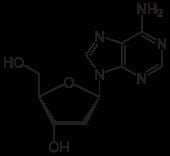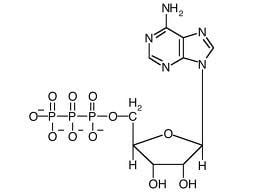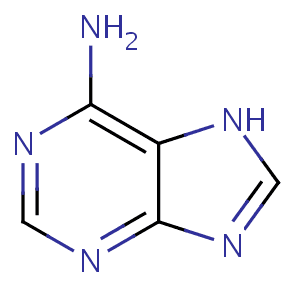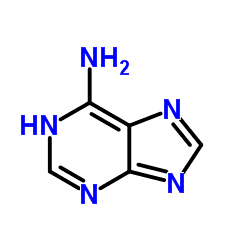Formula C5H5N5 Molar mass 135.13 g/mol Density 1.6 g/cm³ | IUPAC ID 9H-purin-6-amine Melting point 360 °C | |
 | ||
Appearance white to light yellow, crystalline Similar Deoxyribose, Ribose, Purine | ||
Human physiology what is adenine
Adenine /ˈædᵻnᵻn/ (A, Ade) is a nucleobase (a purine derivative). Its derivatives have a variety of roles in biochemistry including cellular respiration, in the form of both the energy-rich adenosine triphosphate (ATP) and the cofactors nicotinamide adenine dinucleotide (NAD) and flavin adenine dinucleotide (FAD). It also has functions in protein synthesis and as a chemical component of DNA and RNA. The shape of adenine is complementary to either thymine in DNA or uracil in RNA.
Contents

The image on the right shows pure adenine, as an independent molecule. When connected into DNA, a covalent bond is formed between deoxyribose sugar and the bottom left nitrogen, so removing the hydrogen. The remaining structure is called an adenine residue, as part of a larger molecule. Adenosine is adenine reacted with ribose as used in RNA and ATP; deoxyadenosine adenine attached to deoxyribose, as is used to form DNA.

Adenine chemistry
Structure

Adenine forms several tautomers, compounds that can be rapidly interconverted and are often considered equivalent. However, in isolated conditions, i.e. in an inert gas matrix and in the gas phase, mainly the 9H-adenine tautomer is found.
Biosynthesis

Purine metabolism involves the formation of adenine and guanine. Both adenine and guanine are derived from the nucleotide inosine monophosphate (IMP), which in turn is synthesized from a pre-existing ribose phosphate through a complex pathway using atoms from the amino acids glycine, glutamine, and aspartic acid, as well as the coenzyme tetrahydrofolate.
Function

Adenine is one of the two purine nucleobases (the other being guanine) used in forming nucleotides of the nucleic acids. In DNA, adenine binds to thymine via two hydrogen bonds to assist in stabilizing the nucleic acid structures. In RNA, which is used for protein synthesis, adenine binds to uracil.

Adenine forms adenosine, a nucleoside, when attached to ribose, and deoxyadenosine when attached to deoxyribose. It forms adenosine triphosphate (ATP), a nucleoside triphosphate, when three phosphate groups are added to adenosine. Adenosine triphosphate is used in cellular metabolism as one of the basic methods of transferring chemical energy between chemical reactions.
History

In older literature, adenine was sometimes called Vitamin B4. It is no longer considered a true vitamin or part of the Vitamin B complex. However, two B vitamins, niacin and riboflavin, bind with adenine to form the essential cofactors nicotinamide adenine dinucleotide (NAD) and flavin adenine dinucleotide (FAD), respectively. Hermann Emil Fischer was one of the early scientists to study adenine.

It was named in 1885 by Albrecht Kossel, in reference to the pancreas (a specific gland - in Greek, "aden") from which Kossel's sample had been extracted.
Experiments performed in 1961 by Joan Oró have shown that a large quantity of adenine can be synthesized from the polymerization of ammonia with five hydrogen cyanide (HCN) molecules in aqueous solution; whether this has implications for the origin of life on Earth is under debate.
On August 8, 2011, a report, based on NASA studies with meteorites found on Earth, was published suggesting building blocks of DNA and RNA (adenine, guanine and related organic molecules) may have been formed extraterrestrially in outer space. In 2011, physicists reported that adenine has an "unexpectedly variable range of ionization energies along its reaction pathways" which suggested that "understanding experimental data on how adenine survives exposure to UV light is much more complicated than previously thought"; these findings have implications for spectroscopic measurements of heterocyclic compounds, according to one report.
